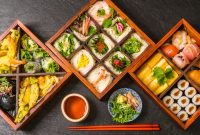Food in Japan
Japanese cuisine, like all Asian cuisine in general, is distinguished by an abundance of seasonings and sauces. In addition to the usual wasabi, ginger and soy sauce, the Japanese use curry, teriyaki, sauces and marinades based on nut paste, sesame, pepper, wine, lemon juice.
Soy (beans) and rice are common as main ingredients in many dishes.
Japan is a country with a long coastline, what can I say, Japan is islands, so seafood, fish, shellfish is what the Japanese know a lot about. Scallop, cucumariid, sea urchin, crab, octopus, caviar are common ingredients in Japanese dishes.
It is also worth mentioning seaweed – nori. They are used as a dressing in soups, salads, and, of course, as a shell for rolls. And if in Russia rolls have been loved for a long time and are perceived as traditionally Japanese food, then in Japan itself, sushi (raw fish on a ball of rice) is much more popular than rolls.
Meat in Japan is of high quality.
One of the interesting dishes is Yakiniku – marbled beef fried on a round grill. The peculiarity of the cooking process is that the guests themselves fry the slices of meat on the grill, which is located in the center of the table. Guests are given special aprons and cutlery.
Separately, I want to mention Japanese sweets, delicious chocolate, caramel, chewing gum, the best ingredients, good quality. Sometimes unusual ingredients are used in sweets, the same rice, licorice, seaweed. A lot of amazing pastries, the smell of which makes your head spin.
From alcohol there are interesting liqueurs, plum and grape wine, brandy.

Writing a review about Japanese food is about the same as answering the questions “do you like to eat?” or even “do you like to breathe?”, and the concept of “food in Japan”, due to its great variety of tastes and genres, does not tolerate a single number and, therefore, a single answer.
I will try, as best I can, to describe the originality and dissimilarity of Japanese cuisine – but not the food and dishes themselves, but Japanese approaches and traditions in the meal.
its island geography and history, as well as hieroglyphs, as a means of creating stereotypes of behavior and thinking.
The smallest consequence is that you will not always find a salt shaker on the table. The chef is supposed to know how to salt and what you like.
Most dishes are prepared according to one – a single recipe, however, from our point of view, in fact, there are many recipe variations, but the result, again, is approximately the same. Let’s say the eel is prepared only like this – boiled – fried in a sweetish brown sauce and nothing else.
Mackerel is always fried – so fatty. Canned fish, objectively only a few types – three – four types of fish in three sauces. But each, separately taken dish, is prepared in this way, and in no other way.
The problem of choice is a real problem for those who come to the restaurant. Therefore, Japan has a large selection of restaurants, but each of them has a rather meager set of dishes. No our “menu – catalogues”, or restaurants of “Russian, Italian and Japanese cuisine”.
On the contrary, let’s say, “the institution of soup noodles”, and only one of its three varieties. In a large beer bar, draft beer of one brand, well, two – light and dark of the same brand, well, three – light, dark and a mixture of 50 to 50. Or three “sorts” of beer – chilled, cold and completely icy, but, again.
, one kind. But, even with such a minimal assortment, people are in no hurry to make an independent choice. Therefore, the marks “recommended” or simply the number in the rating for the sale of this dish are popular. Do what they advise, do as everyone else does, and you won’t be mistaken!… Therefore, in most cases, they choose which establishment to go to in order to order a well-known dish there. And restaurants of various sizes, from multi-story.
to one bar, or with two tables – an uncountable number. I once read that restaurant places in Tokyo are half the number of inhabitants, or so. It is easy to believe.
2. The Japanese love to eat and discuss food. On the main TV channels.
the camera shows a close-up of the presenter, who, very thoughtfully and carefully chews the first piece, then thinks even more , and … when the tension reaches its maximum, …, boom – boom, utters “Yummy!”. Believe it or not, this story can be seen in hundreds of thousands of variations.

In Japan, it is customary to experiment by trying food “overseas”. And, if you like it, adapt it as much as possible to your taste preferences, making it your own. As a result of such “experiments”, Japan has almost the best “international” food – small restaurants of Italian.
Indian, Thai, Chinese, Brazilian, Turkish cuisine, even Ethiopian (I heard from Italians – the best spaghetti is made in Tokyo). There is also Russian. The finale of this “adaptation” is already Japanese cuisine – “Indian” beef curry (nonsense, like “kosher pork”), Japanese hamburger, Russian curry pie, ton katsu (what was once a pork chop), tempura, sushi, etc.
– there were originals, but these originals are no longer similar to the already Japanese dish, and they can begin to be forgotten. And the top of the Japanese art of “adaptation” is the ability to make it so that it is much better than the original. And it shows up in everything, not just food. Japanese “McDonald’s” has purely – Japanese dishes, and Japanese coca – cola is not as eating up stomachs as everywhere else.
And so on.
3. Traditions above all. No matter how people experiment with foreign food, at home, in everyday life, they will prefer Japanese food. Rice is obligatory and common noun, like our bread (in the translation of “Our Father” into Japanese.
“Give us our daily bread today” is translated as, “Give us rice”). “Breakfast”, “lunch” and “dinner” in Japanese, respectively “morning rice”, “afternoon rice” and evening rice”. The food is very modest and low-calorie. The taste of boiled turnips or salted grass is flavored with sauces, but everything is a little bit. Green tea, where the traditional teapot for brewing is cast iron and



